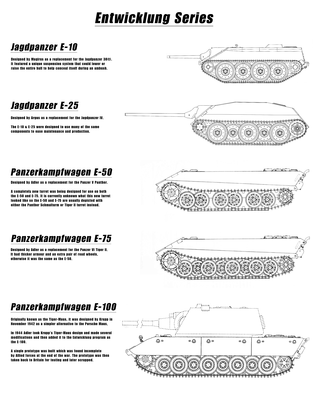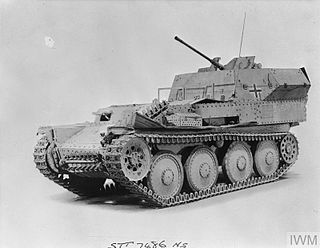
An armoured fighting vehicle or armored fighting vehicle (AFV) is an armed combat vehicle protected by armour, generally combining operational mobility with offensive and defensive capabilities. AFVs can be wheeled or tracked. Examples of AFVs are tanks, armoured cars, assault guns, self-propelled artilleries, infantry fighting vehicles (IFV), and armoured personnel carriers (APC).

A tank destroyer, tank hunter or tank killer is a type of armoured fighting vehicle, predominantly intended for anti-tank duties. They are typically armed with a direct fire artillery gun, also known as a self-propelled anti-tank gun, or missile launcher, also called an anti-tank missile carrier. The vehicles are designed specifically to engage and destroy enemy tanks, often with limited operational capacities.

The Panzer II is the common name used for a family of German tanks used in World War II. The official German designation was Panzerkampfwagen II.

The Panzerkampfwagen IV, commonly known as the Panzer IV, is a German medium tank developed in the late 1930s and used extensively during the Second World War. Its ordnance inventory designation was Sd.Kfz. 161.

This article lists production figures for German armored fighting vehicles during the World War II era. Vehicles include tanks, self-propelled artillery, assault guns and tank destroyers.

The Panzerkampfwagen 38(t), originally known as the ČKD LT vz. 38, was a tank designed during the 1930s, which saw extensive service during World War II. Developed in Czechoslovakia by ČKD, the type was adopted by Nazi Germany following the annexation of Czechoslovakia. With the German Army and other Axis forces, the type saw service in the invasions of Poland, France and the USSR. Production ended in 1942, when its main armament was deemed inadequate. In all, over 1,400 Pz. 38(t)s were manufactured. The chassis of the Pz. 38(t) continued to be produced for the Marder III (1942–1944) with some of its components used in the later Jagdpanzer 38 (1944–1945) tank destroyer and its derivative vehicles.

The Jagdpanzer 38, originally the Leichter Panzerjäger 38(t), known mostly post-war as Hetzer, was a German light tank destroyer of the Second World War based on a modified Czechoslovakian Panzer 38(t) chassis.

The Jagdpanther, Sd.Kfz. 173, was a tank destroyer built by Germany during World War II. The Jagdpanther combined the 8.8 cm Pak 43 anti-tank gun, similar to the main gun of the Tiger II, with the armor and suspension of the Panther chassis.

The Sturmpanzer is a German armoured infantry support gun based on the Panzer IV chassis used in the Second World War. It was used at the Battles of Kursk, Anzio, Normandy, and was deployed in the Warsaw Uprising. It was known by the nickname Brummbär by Allied intelligence, a name which was not used by the Germans. German soldiers nicknamed it the "Stupa", a contraction of the term Sturmpanzer. Just over 300 vehicles were built and they were assigned to four independent battalions.

The Schwerer Panzerspähwagen, is a series of six- and eight-wheeled armoured cars that were used by Germany during the Second World War.

The Jagdpanzer IV / Sd.Kfz. 162, was a German tank destroyer based on the Panzer IV chassis and built in three main variants. As one of the casemate-style turretless Jagdpanzer designs, it was developed against the wishes of Heinz Guderian, the inspector general of the Panzertruppen, as a replacement for the Sturmgeschütz III. Guderian objected against the needless diversion of resources from Panzer IV tank production, as the StuG III was still more than adequate for its role.

The Entwicklung series, more commonly known as the E-Series, was a late-World War II attempt by Nazi Germany to produce a standardised series of tank designs. There were to be standard designs in five different weight classes from which several specialised variants were to be developed. Design standardisation was envisioned to bring improvements over extreme complexity of previous tank designs that resulted in poor production rates and mechanical unreliability.

The Flakpanzer 38(t), officially named Flakpanzer 38(t) auf Selbstfahrlafette 38(t) Ausf M , was a German self-propelled anti-aircraft gun used in World War II. It is sometimes incorrectly referred to as the Gepard, which may lead to confusion with the unrelated Flakpanzer Gepard.
The Panzerkampfwagen I was a light tank produced in Germany in the 1930s. The Panzer I was built in several variants and was the basis for a number of variants listed below.

The Sd.Kfz. 234, was a family of armoured cars designed and built in Germany during World War II. The vehicles were lightly armoured, armed with a 20, 50 or 75 mm main gun, and powered by a Tatra V12 diesel engine. The Sd.Kfz. 234 broadly resembles the appearance of Sd.Kfz. 231 .

This article deals with the tanks serving in the German Army throughout history, such as the World War I tanks of the Imperial German Army, the interwar and World War II tanks of the Nazi German Wehrmacht, the Cold War tanks of the West German and East German Armies, all the way to the present day tanks of the Bundeswehr.

Nahkampfkanone 2 is a prototype tank destroyer of Swiss design.

The Mittlerer Panzer 1958 or Panzer 58 was a medium tank of Swiss design. Twelve tanks were produced and later converted to Panzer 61s.

Eidgenössische Konstruktionswerkstätte English: "Federal Constructions Works", short K+W, was a Swiss state-owned enterprise, with the aim of making the Swiss military independent of foreign sources for its equipment needs. It was established in 1867 in Thun and produced artillery, vehicles and other typical military equipment. In 1914 Switzerland put in an effort to make itself independent of foreign suppliers of military aircraft and started the production of the DH-1 in Thun. Long-standing connections to the ETH Zurich ensured the necessary know-how. 1940 the aviation department moved from Thun to Emmen (LU) and in 1943 it became a separate unit of the Swiss Armed Forces independent under the name of Eidgenössisches Flugzeugwerk (F+W). The Eidgenoessische Konstruktionswerkstaette focused now on the production of armoured fighting vehicles for the Swiss Army, both of its own designs and licensed production of M113 armored personnel carriers and Leopard 2 tanks and other land systems for the Swiss Army. Since 1995 it changed its name several times, started exporting and is now part of RUAG Defence.


















